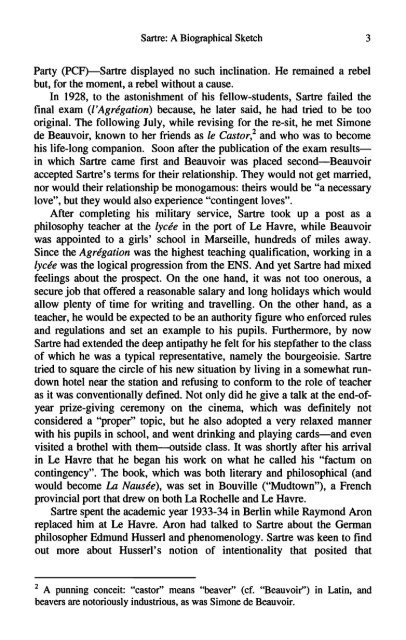Sartre's second century
Sartre's second century
Sartre's second century
You also want an ePaper? Increase the reach of your titles
YUMPU automatically turns print PDFs into web optimized ePapers that Google loves.
Sartre: A Biographical Sketch 3<br />
Party (PCF)—Sartre displayed no such inclination. He remained a rebel<br />
but, for the moment, a rebel without a cause.<br />
In 1928, to the astonishment of his fellow-students, Sartre failed the<br />
final exam (UAgregatiori) because, he later said, he had tried to be too<br />
original. The following July, while revising for the re-sit, he met Simone<br />
de Beauvoir, known to her friends as le Castor? and who was to become<br />
his life-long companion. Soon after the publication of the exam results—<br />
in which Sartre came first and Beauvoir was placed <strong>second</strong>—Beauvoir<br />
accepted <strong>Sartre's</strong> terms for their relationship. They would not get married,<br />
nor would their relationship be monogamous: theirs would be "a necessary<br />
love", but they would also experience "contingent loves".<br />
After completing his military service, Sartre took up a post as a<br />
philosophy teacher at the lycee in the port of Le Havre, while Beauvoir<br />
was appointed to a girls' school in Marseille, hundreds of miles away.<br />
Since the Agregation was the highest teaching qualification, working in a<br />
lycee was the logical progression from the ENS. And yet Sartre had mixed<br />
feelings about the prospect. On the one hand, it was not too onerous, a<br />
secure job that offered a reasonable salary and long holidays which would<br />
allow plenty of time for writing and travelling. On the other hand, as a<br />
teacher, he would be expected to be an authority figure who enforced rules<br />
and regulations and set an example to his pupils. Furthermore, by now<br />
Sartre had extended the deep antipathy he felt for his stepfather to the class<br />
of which he was a typical representative, namely the bourgeoisie. Sartre<br />
tried to square the circle of his new situation by living in a somewhat rundown<br />
hotel near the station and refusing to conform to the role of teacher<br />
as it was conventionally defined. Not only did he give a talk at the end-ofyear<br />
prize-giving ceremony on the cinema, which was definitely not<br />
considered a "proper" topic, but he also adopted a very relaxed manner<br />
with his pupils in school, and went drinking and playing cards—and even<br />
visited a brothel with them—outside class. It was shortly after his arrival<br />
in Le Havre that he began his work on what he called his "factum on<br />
contingency". The book, which was both literary and philosophical (and<br />
would become La Nausee), was set in Bouville ("Mudtown"), a French<br />
provincial port that drew on both La Rochelle and Le Havre.<br />
Sartre spent the academic year 1933-34 in Berlin while Raymond Aron<br />
replaced him at Le Havre. Aron had talked to Sartre about the German<br />
philosopher Edmund Husserl and phenomenology. Sartre was keen to find<br />
out more about Husserl's notion of intentionality that posited that<br />
2 A punning conceit: "castor" means "beaver" (cf. "Beauvoir") in Latin, and<br />
beavers are notoriously industrious, as was Simone de Beauvoir.
















